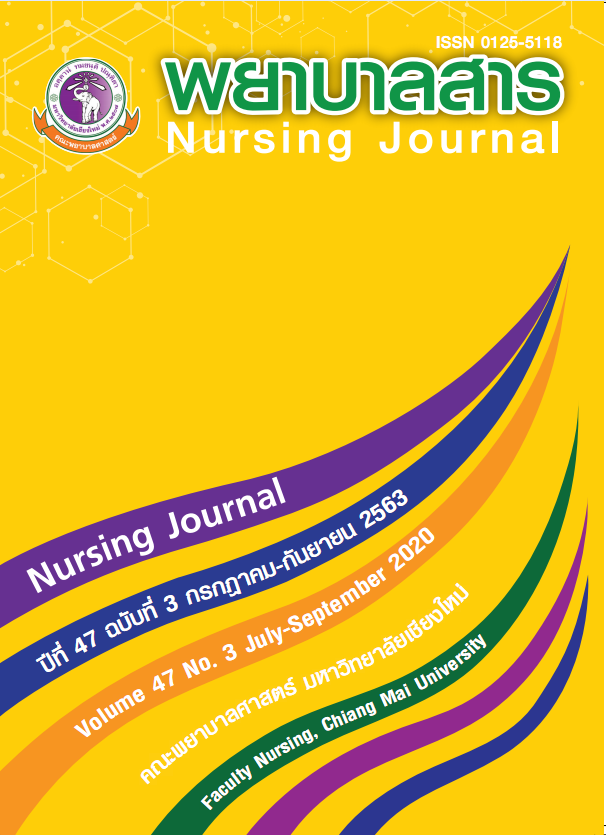Effect of Imagery Relaxation Training on Stress Among Pregnant Women with Preterm Labor
Keywords:
imagery relaxation training, stress, pregnant women with preterm labor, routine careAbstract
Stress occurring in pregnant women with preterm labor affects pregnant women’s physical and psychological health and also affects fetal health. The purpose of this quasi-experimental research study was to examine the effect of imagery relaxation training on stress among pregnant women with preterm labor. The participants were 44 pregnant women with preterm labor receiving tocolytic agents who were admitted to Lumphun Hospital from May to August 2017. The subjects were selected according to the inclusion criteria and assigned into the control and experimental groups with twenty-two in each group which was matched according to age. The experimental group received imagery relaxation training with routine care and the control group received only routine care. The research intervention instruments consisted of imagery relaxation training plan and guided imagery CD developed by Nahathai Wongpakaran (Wongpakaran, 2010) and the research evaluation instrument included personal data form and the stress visual analog scale. Data were analyzed using descriptive statistics and a one-way repeated measures ANOVA.
The research revealed that pregnant women in the experimental group had significantly lower stress scores than that of the control group (p<.001).
The results of this study can be used as a guideline for the nurse-midwives to improve the quality of nursing care in effectively reducing stress in pregnant women with preterm labor.
References
Ackerman, C. J., & Turkoski, B. (2000). Using guided imagery to reduce pain and anxiety. Home Health care, 18 (8), 524-531.
American Congress of Obstetricians and Gynecologists. (2015). Preterm (premature) labor and birth. Retrieved from http://www.acog.org/Patients/FAQs/Preterm-premature-laborand-birth
Buelow, J. M. (1991). A correlational study of disabilities, st ressors and coping methods in victims of multiple sclerosis. Journal of Neuroscience Nursing, 23 (4), 247-252.
Burns, N., & Grove, S. K. (2005). The practice of nursing research: Conduct, critique, and utilication (5th ed.). St. Louis: Elsevier Saunders.
Chuang, L. L., Lin, L. C., Cheng, P.-J., Chen, C.-H., Wu, S.-C., & Chang, C.-L. (2011). Effects of a relaxation training programme on immediate and prolonged stress responses in women with preterm labour. Journal of Advanced Nursing, 68 (1), 170-180. doi:10.1111/j.1365-2648.2011.05765.xO
Cunningham, F. G., Leveno, K. J., Bloom, S. L., Hauth, J. C., Rouse, D. J., & Spong, C. Y. (2010). William obstetrics (23rd ed.). New York: McGraw-Hill.
Danerek, M., & Dykes, A. K. (2008). A theoretical model of pare nts’ experiences of threat of preterm birth in Sweden. Midwifery, 24 (4), 416-424.
Deeprompt, U. (2003). Review article: Guided Imagery. Journal of Mental Health of Thailand, 11 (2), 87-95. (In Thai)
Dossey, B.M. (1997). Imagery in core curriculum for holistic nu rsing. Gaithersburg, Md: Aspen Publishers.
Dossey, B. (1995). Complementary modalities/Past 3: Using image ry to help you patient heal. American journal of Nursing, 95 (6), 41-47.
Gupton, A., Heaman M., & Ashcroft, T. (1997). Bed rest from the perspective of the high risk pregnant woman. Journal of Obstetric Gynecologic and Neonatal Nursing, 26 (4), 423-430.
Janke, J. (1999). The effect of relaxation therapy on preterm l abor outcomes. Journal of Obstetric Gynecologic & Neonatal Nursing, 28 (3), 255-263.
Khianman, B., Pattanittum, P., Thinkhamrop, J., & Lumbiganon, P. (2012). Relaxation therapy for preventing and treating preterm labour (Review). Cochrane Database of Systematic Reviews, 8. doi:10.1002/14651858.CD007426.pub2 (In Thai)
Kim, S. D., & Kim, H. S. (2005). Effects of a relaxation breath ing exercise on anxiety, depression, and leukocyte in hematopoietic stem cell transplantation patien ts. Cancer Nursing, 28 (1), 79-83.
Lazarua, R. S., & Folkman, S. (1984). Stress, appraisal and coping. New York: Springer.
Lertkawinanan, S., Kantaruksa, K., & Baosoung, C. (2016). Systematic review of stress management among women with preterm labor. Nursing Journal, 43 (1), 33-43. (In Thai)
Maloni, J. A. (2010). Antepartum bed rest for pregnancy compli cations: Efficacy and safety for preventing preterm birth. Biological Research for Nursing, 12 (2), 106-124. doi:10.1177/1099800410375978
Mizrahi, M. C., Rejcher-Atir, R., Levy, S., Haramati, S., Wenarower, D., Israeli, E., & Goldin, E. (2012). Effects of guided imagery with relaxation training on anxiety and quality of life among patients with inflammatory bowel disease. Psychology Health, 27 (12), 63-79. doi:10.1080/08870446 . 2012.691169
Pranetpholkrung, R. (2008). The use of yoga breathing control t echnique in reducing stress among pregnant women with preterm labor pain. Journal of faculty of nursing Khon Kaen University, 31(4), 48-57. (In Thai)
Rubarth, L. B., Schoening, A. M., Cosimano, A., & Sandhurst, H. (2012). Womem’s experience of hospitalized bed rest during high-risk pregnancy. Journal of Obstetric Gynecologic and Neonatal Nursing, 41(3), 398-404. doi:10.1111/j.1552-6909.2012.01349.xA
Sangchart, B., Sonbun, A., Photitaen, T., & Srisaenpang P. (2002). Alternative therapy of pain management among patients with pain. Khon Kaen: Faculty of Nursing, Khon Kaen University. (In Thai)
Seaward, B. L. (2009). Managing stress: Principles and strategies for health and wellbeing (6th ed.). Canada: Jones and Bartlett Publishers.
Stephens, R. L. (1993). Imagery: A strategic intervention to empower clients part I-review of Research literature. Clinical Nurse Specialist, 7 (4), 170-174.
Wongpakaran, N. (2010). Guided imagery for Elderly 2010. In, Tools and procedures for guided imagery (revised version 2016). Chiang Mai: Department of Psychiatry, Faculty of Medicine, Chiang Mai University. (In Thai)
Downloads
Published
How to Cite
Issue
Section
License
บทความที่ได้รับการตีพิมพ์เป็นลิขสิทธิ์ของวารสารพยาบาลสาร
ข้อความที่ปรากฏในบทความแต่ละเรื่องในวารสารวิชาการเล่มนี้เป็นความคิดเห็นส่วนตัวของผู้เขียนแต่ละท่านไม่เกี่ยวข้องกับมหาวิทยาลัยเชียงใหม่ และคณาจารย์ท่านอื่นๆในมหาวิทยาลัยฯ แต่อย่างใด ความรับผิดชอบองค์ประกอบทั้งหมดของบทความแต่ละเรื่องเป็นของผู้เขียนแต่ละท่าน หากมีความผิดพลาดใด ๆ ผู้เขียนแต่ละท่านจะรับผิดชอบบทความของตนเองแต่ผู้เดียว






